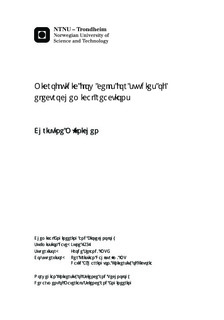Microfluidic flow cells for studies of electrochemical reactions
Master thesis
Permanent lenke
http://hdl.handle.net/11250/249108Utgivelsesdato
2012Metadata
Vis full innførselSamlinger
Sammendrag
In this project the main goal was to establish a routine for making a microfluidic flow cell (MFFC) using soft lithography methods, and test the flow cell with different electrolytes, sulphuric acid and a ruthenium red-ox couple, and eventually use the established routine to make a microfluidic fuel cell and test it. A routine was established using the negative photoresist ma-N405. The photoresist was overdeveloped to make sure an undercut profile was reached, which proved to be necessary for the subsequent metal lift-off. Titanium (10 nm) and platinum (25 nm) were vapor deposited on the glass chips, and the lift-off process was completed in a couple of days. Flow channels of two different heights (about 15 and 100 µm) were made by making an impression in PDMS. A low flow channel, height of 15 µm, showed a significant electrolyte resistance in the experimental electrochemical work, and none of the experiments gave the expected results. The electrolyte resistance was measured by electrochemical impedance spectroscopy and taken to be the value corresponding to the high frequency intersection of the real axis. In addition, this resistance was estimated from cyclic voltammetry and taken to be the reciprocal of the slope of the curve, and was found to vary between 104-107 Ω. The results from EIS and CV were compared, and they overlapped quite well. An MFFC with a channel height of 100 µm and 500 µm electrodes, resulted in a significant decrease in measured electrolyte resistance and gave improved electrochemical results. The electrolyte resistance was measured from EIS and was reduced a lot to about 300 - 10000 Ω. These results were not compared with linear regression of the linear hydrogen area since the hydrogen area was no longer linear. The cell was tested with a ruthenium red-ox couple (hexaammineruthenium(II)chloride and hexaammineruthenium(III)chloride), and an external hydrogen reference electrode placed in the outlet was found to be simpler to control than an internal reference electrode. The potential limits were -0.3 and 0.3 V vs. an external hydrogen electrode in the same electrolyte. The effect of flow rate, sweep rate and oxygen content in the electrolyte was investigated.
